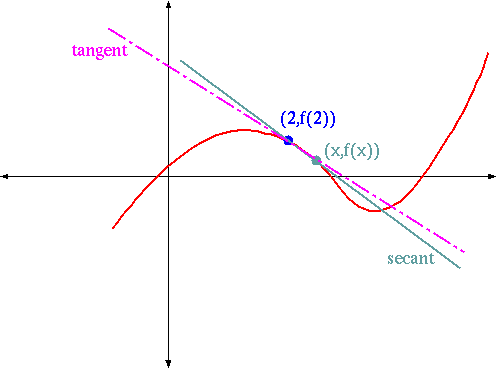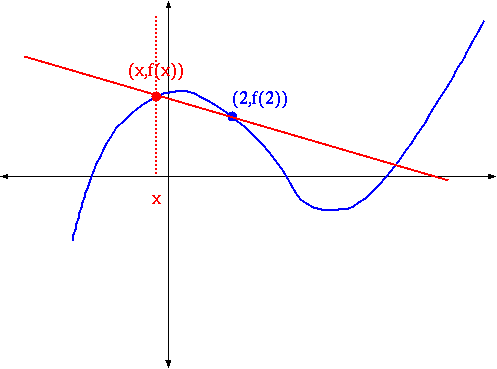
We certainly know what we mean by a line tangent to a curve at a point. The line goes through that point, and the slope is the same as that of the curve. But, how do we measure that slope? Let's say, to make the idea seem more precise - and to see how we will compute this measurement - let's say that the curve is the graph of a function y = f(x) , that is, the curve is the set of points (x,f(x)) . We want to find the slope at, say, x = 2 . How do we do it? We could just ``carefully measure'' it, but that would probably have some error, and what do we mean by how we are measuring it? We need a procedure that will lead to the slope of the curve. The way to do it is to find the slope of something simpler, a line, and relate that line's slope to that of the curve. The relationship is that the line we look at is one near the tangent line, which we construct (here is the appeal to the special cases we already know about) by taking the line through (2,f(2)) and a nearby point, (x,f(x)) , for x near 2. This is called a secant line.

| ||||||||||||||||
This animation shows you the idea of moving the second point (x,f(x)) along the curve towards (2,f(2)) , (which we do by simply moving the x nearer to 2 ). Notice how the secant line gets closer to being tangent to the curve at (2,f(2)) as x approaches 2 .

| |||||||||||||||||||||||||||||||||||
A similar idea is behind our notion of velocity. We can see immediately how fast we are going, we can find the instantaneous velocity of a car we are driving, just by looking at the speedometer. But what is that really measuring? The average velocity makes sense, it's the distance traveled over a specific amount of time. But the speedometer doesn't measure that, it has a reading at each instant, and it doesn't calculate an average velocity.
But the idea of instantaneous velocity of a moving car, at a specific time,
has to be interpreted as another limiting process, taking average velocities
over shorter and shorter time intervals:
|
If you plot the distance on the vertical axis, and time on the horizontal, then you have the same picture as before, and the velocity is the slope of that graph.

Copyright (c) 2000 by David L. Johnson.